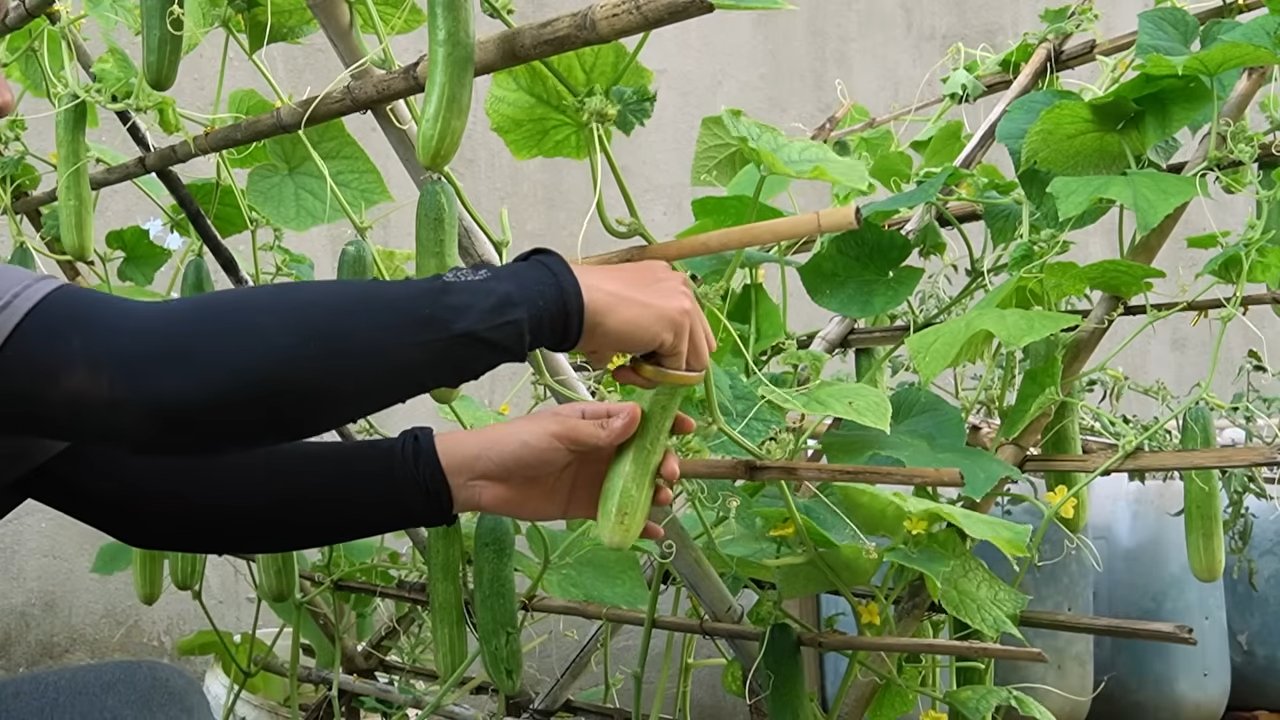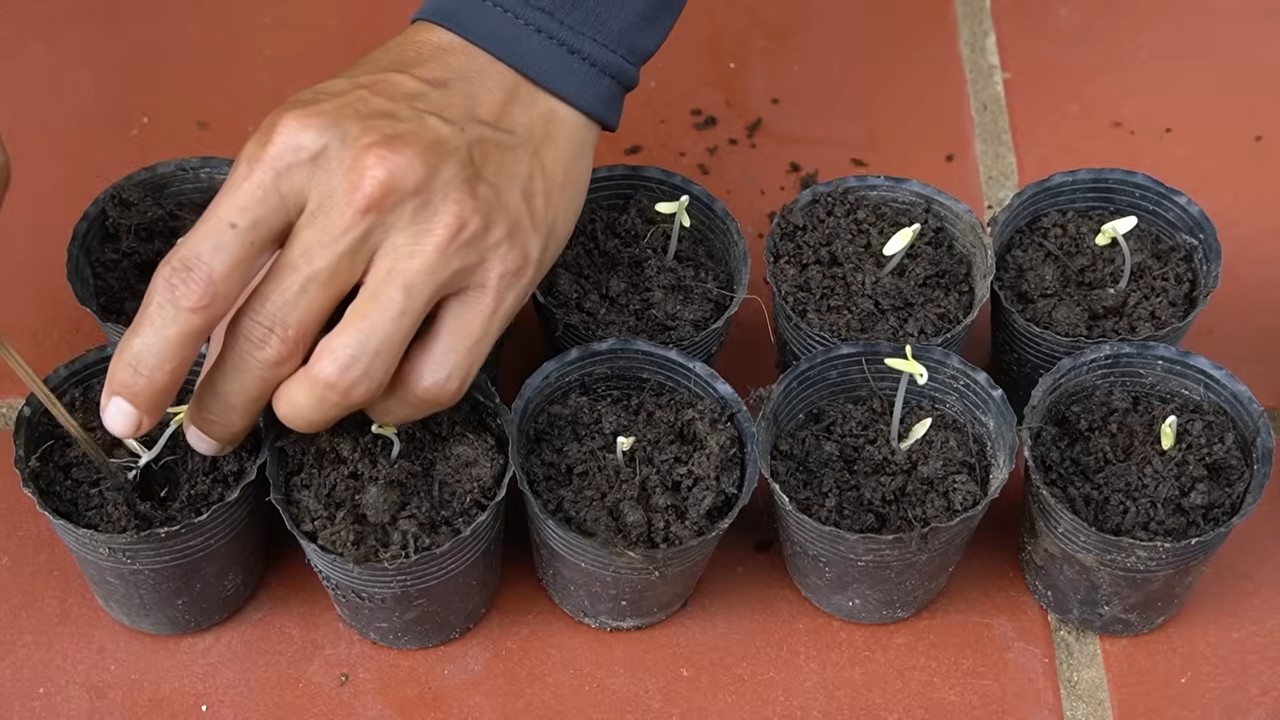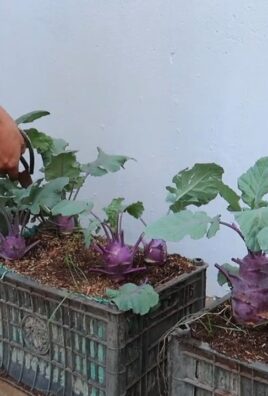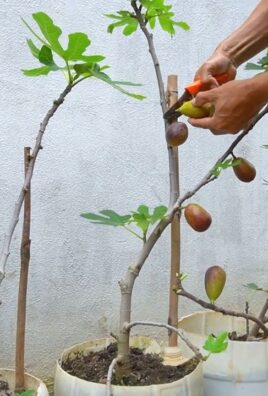Growing cucumbers vertically isn’t just a gardening trend; it’s a game-changer for anyone looking to maximize their harvest and minimize space! I remember my grandmother, a seasoned gardener, always lamenting about her sprawling cucumber vines taking over her entire vegetable patch. She wished she had known about this clever technique sooner! For centuries, gardeners have sought ways to optimize their yields, and vertical gardening, while perhaps not always with cucumbers specifically, has roots in ancient practices like the Hanging Gardens of Babylon.
Are you tired of battling powdery mildew on your cucumber leaves, or constantly tripping over sprawling vines in your garden? Do you dream of a bountiful cucumber harvest but lack the space for a traditional sprawling garden? Then this DIY guide is exactly what you need! Growing cucumbers vertically offers a multitude of benefits, from improved air circulation and reduced disease to easier harvesting and a more aesthetically pleasing garden. I’m going to show you simple, step-by-step instructions and clever hacks to transform your cucumber growing experience. Get ready to say goodbye to garden clutter and hello to a vertical cucumber paradise!

DIY Vertical Cucumber Garden: Maximize Space and Yield!
Hey there, fellow gardeners! Are you dreaming of overflowing cucumber harvests but short on garden space? Well, I’ve got the perfect solution for you: growing cucumbers vertically! It’s a game-changer, trust me. Not only does it save space, but it also improves air circulation, reduces disease, and makes harvesting a breeze. Let’s dive into how you can create your own vertical cucumber oasis.
Why Grow Cucumbers Vertically?
Before we get our hands dirty, let’s quickly recap why vertical gardening is so awesome for cucumbers:
* Space Saver: Perfect for small gardens, balconies, or patios.
* Improved Air Circulation: Reduces the risk of fungal diseases like powdery mildew.
* Easier Harvesting: No more bending over and searching under sprawling vines!
* Cleaner Fruits: Cucumbers stay off the ground, preventing rot and blemishes.
* Increased Sunlight Exposure: More sunlight means more delicious cucumbers!
Choosing the Right Cucumber Variety
Not all cucumbers are created equal when it comes to vertical growing. Bush varieties are generally not suitable, as they are designed to be compact. You’ll want to choose vining varieties that naturally climb. Here are a few of my favorites:
* ‘Spacemaster’: A compact vine, perfect for smaller trellises.
* ‘Bush Champion’: While technically a bush variety, it can be trained up a small trellis with some effort.
* ‘Marketmore 76’: A classic slicing cucumber that climbs well.
* ‘Diva’: A parthenocarpic (seedless) cucumber that’s easy to grow and disease-resistant.
* ‘Lemon Cucumber’: A fun, round cucumber with a mild flavor that climbs beautifully.
* ‘Armenian Cucumber’ (also known as ‘Yard Long Cucumber’): Produces long, slender fruits and is a vigorous climber.
Building Your Vertical Cucumber Support System
There are several ways to support your climbing cucumbers. Here are a few options, ranging from simple to slightly more involved:
* Trellis: A classic choice! You can buy a pre-made trellis or build your own from wood or metal.
* Netting: Attach netting to a frame or between posts. Cucumber tendrils will easily grab onto the netting.
* Cattle Panel: A sturdy and durable option. Simply lean the panel against a wall or fence.
* Tomato Cage (Modified): For smaller vining varieties, you can use a tomato cage. You might need to add extra support as the plant grows.
* DIY String System: Suspend strings from an overhead structure (like a pergola or balcony) and tie them to the base of the cucumber plant.
For this guide, I’m going to focus on building a simple and effective wooden trellis. It’s relatively easy to construct and will provide ample support for your cucumber vines.
Materials You’ll Need for a Wooden Trellis
* Lumber:
* Two 6-foot long 2x4s (for the vertical posts)
* One 4-foot long 2×4 (for the top horizontal support)
* One 4-foot long 2×4 (for the bottom horizontal support)
* Several 4-foot long 1x2s (for the horizontal rungs – I recommend about 6-8)
* Hardware:
* Wood screws (various lengths)
* Exterior wood glue
* Tools:
* Saw (circular saw or hand saw)
* Drill with drill bits
* Screwdriver
* Measuring tape
* Pencil
* Safety glasses
* Gloves
Step-by-Step Instructions: Building Your Wooden Trellis
Okay, let’s get building!
1. Prepare the Vertical Posts: Take your two 6-foot 2x4s. These will be the main supports for your trellis. If you want to bury the bottom of the posts in the ground for extra stability, you’ll need to add extra length (at least 1-2 feet). I prefer to use metal post anchors, which I’ll explain later.
2. Attach the Horizontal Supports: Take your two 4-foot 2x4s. These will form the top and bottom of the trellis frame. Apply wood glue to the ends of the 4-foot 2x4s and attach them to the inside of the 6-foot vertical posts, creating a rectangular frame. Use wood screws to secure the joints. Make sure the frame is square!
3. Add the Horizontal Rungs: Now, it’s time to add the 1×2 rungs that the cucumber vines will climb. Decide on the spacing between the rungs. I usually space them about 6-8 inches apart. Mark the locations on the vertical posts with a pencil.
4. Attach the Rungs: Apply wood glue to the ends of the 1×2 rungs and attach them to the vertical posts at the marked locations. Use wood screws to secure each rung. Make sure the rungs are level.
5. Reinforce the Joints (Optional): For extra strength, you can add small triangular pieces of wood (gussets) to the corners of the frame. This will help prevent the trellis from wobbling.
6. Sand and Seal (Optional): If you want to protect the wood from the elements, you can sand the trellis smooth and apply a coat of exterior wood sealant or paint.
Planting Your Cucumbers
Now that your trellis is built, it’s time to plant your cucumbers!
1. Choose a Sunny Location: Cucumbers need at least 6-8 hours of sunlight per day.
2. Prepare the Soil: Cucumbers prefer well-drained, fertile soil. Amend the soil with compost or other organic matter.
3. Planting Seeds or Seedlings: You can either direct sow cucumber seeds or transplant seedlings. If you’re starting from seeds, sow them about 1 inch deep and 6 inches apart. If you’re transplanting seedlings, space them about 12 inches apart.
4. Water Thoroughly: Water the newly planted cucumbers well.
Training Your Cucumber Vines
As your cucumber vines grow, you’ll need to train them to climb the trellis.
1. Gently Guide the Vines: As the vines develop tendrils, gently guide them towards the trellis rungs or netting. The tendrils will naturally grab onto the support.
2. Tie Vines (If Necessary): If the vines are struggling to grab onto the support, you can tie them loosely with soft twine or plant ties.
3. Prune as Needed: Prune away any yellowing or diseased leaves. You can also prune the tips of the vines to encourage branching.
Watering and Fertilizing
Cucumbers are thirsty plants, so water them regularly, especially during hot, dry weather. Aim for about 1 inch of water per week. Fertilize your cucumbers every 2-3 weeks with a balanced fertilizer.
Dealing with Pests and Diseases
Keep an eye out for common cucumber pests like aphids, cucumber beetles, and squash bugs. You can control these pests with insecticidal soap or neem oil. Prevent fungal diseases by providing good air circulation and avoiding overhead watering.
Harvesting Your Cucumbers
Harvest your cucumbers when they are the desired size and color. The exact size will depend on the variety. Regular harvesting will encourage the plant to produce more cucumbers.
Using Post Anchors for Added Stability
Earlier, I mentioned using metal post anchors. These are fantastic for providing extra stability to your trellis, especially if you’re concerned about wind. Here’s how to use them:
1. Choose the Right Anchor: Select post anchors that are designed for the size of your 2×4 posts.
2. Position the Anchors: Place the anchors where you want the base of your trellis to be.
3. Secure the Anchors: Use concrete screws or other appropriate fasteners to secure the anchors to a concrete patio or deck. If you’re placing the anchors in soil, you’ll need to dig a small hole and partially bury the anchor.
4. Insert the Posts: Slide the bottom of the trellis posts into the post anchors.
5. Secure the Posts: Use screws or bolts to secure the posts to the anchors.
Using post anchors will make your trellis much more stable and less likely to tip over in strong winds.
Troubleshooting Tips
* Yellowing Leaves: Could be a sign of overwatering, underwatering, nutrient deficiency, or disease. Check the soil moisture and adjust watering accordingly. Fertilize with a balanced fertilizer.
* Lack of Fruit: Could be due to poor pollination, lack of sunlight, or nutrient deficiency. Make sure the plants are getting enough sunlight and fertilize with a fertilizer

Conclusion
So, there you have it! Growing cucumbers vertically isn’t just a gardening trend; it’s a game-changer for anyone looking to maximize their yield, minimize garden pests, and enjoy a cleaner, more manageable harvest. We’ve explored the myriad benefits, from improved air circulation that combats fungal diseases to the space-saving advantages that make even the smallest balcony a viable cucumber patch.
But the real magic lies in the simplicity and adaptability of this method. Whether you’re a seasoned gardener with a sprawling vegetable plot or a beginner with a tiny urban balcony, vertical cucumber growing is within your reach. The initial setup might seem like a bit of effort, but the long-term rewards – healthier plants, abundant harvests, and a visually stunning garden – are well worth it.
Think of the possibilities! You could construct a simple trellis from bamboo stakes and twine, creating a rustic and charming backdrop for your climbing cucumbers. Or, if you’re feeling more ambitious, you could build a sturdy A-frame trellis that doubles as a decorative garden feature. For those with limited space, a tomato cage or even a repurposed pallet can serve as an excellent vertical support system.
And don’t be afraid to experiment with different cucumber varieties. While bush varieties are naturally compact, many vining types, such as ‘Spacemaster’ or ‘Little Leaf’, are specifically bred for container gardening and vertical growth. Consider pickling cucumbers for a continuous supply of crunchy snacks, or try slicing cucumbers for refreshing salads. The choice is yours!
Beyond the practical benefits, there’s a certain satisfaction that comes from nurturing your own food. Watching your cucumber vines climb and flourish, laden with vibrant green fruits, is a truly rewarding experience. It’s a connection to nature, a source of fresh, healthy produce, and a testament to your own gardening skills.
We wholeheartedly encourage you to give growing cucumbers vertically a try. It’s an investment in your garden, your health, and your overall well-being. Don’t be intimidated by the prospect of building a trellis or training the vines. Start small, experiment with different techniques, and learn from your experiences.
Most importantly, share your journey with us! We’d love to hear about your successes, your challenges, and your creative solutions. Post photos of your vertical cucumber gardens on social media, tag us in your posts, and let’s build a community of vertical gardening enthusiasts. Together, we can transform our gardens, one cucumber vine at a time. So, grab your seeds, build your trellis, and get ready to enjoy a bountiful harvest of delicious, homegrown cucumbers!
Frequently Asked Questions (FAQ)
What type of trellis is best for growing cucumbers vertically?
The “best” type of trellis really depends on your space, budget, and aesthetic preferences. However, some popular and effective options include:
* **A-Frame Trellis:** This is a sturdy and visually appealing option that provides ample support for heavy cucumber vines. It’s relatively easy to build with wood or metal and offers good stability.
* **Bamboo Trellis:** A more rustic and budget-friendly option. Bamboo stakes can be tied together with twine to create a simple yet effective trellis. It’s lightweight and easy to move around.
* **Tomato Cages:** These are readily available and inexpensive. They work well for smaller cucumber varieties or for training young vines. However, they may not be strong enough to support very large or heavy plants.
* **Pallet Trellis:** Repurposing a wooden pallet is a great way to create a vertical garden on a budget. Simply lean the pallet against a wall or fence and train the cucumber vines to climb through the slats.
* **Netting or Mesh:** A simple and versatile option that can be attached to a frame or hung between posts. It provides good support for the vines and allows for good air circulation.
Consider the size of your cucumber plants, the weight of the fruit, and the overall look you’re trying to achieve when choosing a trellis.
How often should I water cucumbers grown vertically?
Cucumbers grown vertically tend to dry out faster than those grown on the ground, especially in containers. Therefore, consistent watering is crucial. Aim to water deeply and regularly, especially during hot and dry weather. Check the soil moisture daily and water when the top inch feels dry to the touch. In general, you may need to water your vertical cucumbers every day or even twice a day during peak growing season. Using a soaker hose or drip irrigation system can help ensure consistent moisture delivery.
What kind of soil is best for vertical cucumber growing?
Cucumbers thrive in well-draining, fertile soil that is rich in organic matter. A good potting mix specifically formulated for vegetables is ideal for container gardening. You can also amend your garden soil with compost, aged manure, or other organic materials to improve its drainage and fertility. The ideal soil pH for cucumbers is between 6.0 and 7.0.
How do I train cucumber vines to climb the trellis?
Training cucumber vines to climb is relatively easy. As the vines grow, gently guide them towards the trellis and use soft plant ties or twine to secure them to the support structure. Regularly check the vines and redirect them as needed. Avoid tying the vines too tightly, as this can restrict their growth. With a little encouragement, the vines will naturally start to cling to the trellis on their own.
What are some common pests and diseases that affect vertical cucumbers, and how can I prevent them?
Vertical cucumber growing can help reduce the risk of some pests and diseases, but it’s still important to be vigilant. Common pests include aphids, cucumber beetles, and squash bugs. Diseases include powdery mildew, downy mildew, and bacterial wilt.
Here are some preventative measures:
* **Good Air Circulation:** Ensure good air circulation around the plants by spacing them properly and pruning any overcrowded foliage.
* **Watering Practices:** Water at the base of the plants to avoid wetting the leaves, which can promote fungal diseases.
* **Crop Rotation:** Rotate your crops each year to prevent the buildup of soilborne pests and diseases.
* **Insecticidal Soap or Neem Oil:** Use insecticidal soap or neem oil to control aphids and other pests.
* **Disease-Resistant Varieties:** Choose cucumber varieties that are resistant to common diseases.
* **Regular Inspection:** Regularly inspect your plants for signs of pests or diseases and take action promptly.
Can I grow cucumbers vertically in containers?
Absolutely! In fact, growing cucumbers vertically in containers is a great option for those with limited space. Choose a large container (at least 5 gallons) with good drainage holes. Use a high-quality potting mix and provide a sturdy trellis or support structure. Be sure to water and fertilize regularly, as container-grown plants tend to dry out and deplete nutrients more quickly.
How much sunlight do vertical cucumbers need?
Cucumbers need at least 6-8 hours of direct sunlight per day to thrive. Choose a sunny location for your vertical cucumber garden. If you’re growing cucumbers in containers, you can move them around to ensure they get enough sunlight.
When is the best time to harvest cucumbers grown vertically?
Harvest cucumbers when they are young and tender, before the seeds become too large and the skin becomes tough. The ideal size for harvesting depends on the variety. Pickling cucumbers are typically harvested when they are 2-4 inches long, while slicing cucumbers are harvested when they are 6-8 inches long. Regular harvesting encourages the plants to produce more fruit.
What are some good companion plants for vertical cucumbers?
Companion planting can help improve the health and productivity of your cucumber plants. Some good companion plants for cucumbers include:
* **Marigolds:** Repel nematodes and other pests.
* **Nasturtiums:** Attract aphids away from cucumbers.
* **Dill:** Attract beneficial insects that prey on cucumber pests.
* **Beans:** Fix nitrogen in the soil, which benefits cucumbers.
* **Radishes:** Deter cucumber beetles.
Avoid planting cucumbers near aromatic herbs like sage, as they can inhibit cucumber growth.




Leave a Comment